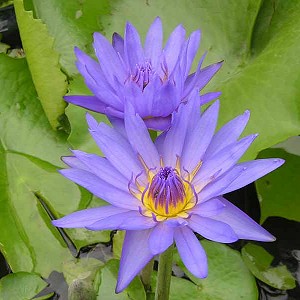
|
|
Egyptian Blue
Water-lily
( Nymphaea nouchali var. caerulea)
|
Waterlily
- Nymphaea spp.
Nymphaea is a genus of aquatic plants in the family
Nymphaeaceae. The common name, shared with some other genera in the same family, is
water-lily or waterlily. Nymphaea leaves have a radial notch from the circumference to the petiole
(leaf stem) in the center. There are about 50 species in the genus, which has a cosmopolitan
distribution. Many of the water-lilies familiar in water gardening are hybrids.
The genus is closely related to
Nuphar, differing in the petals being much larger than the sepals, whereas in
Nuphar, the petals are much smaller than the 4-6 yellow-coloured sepals. The fruit maturation also
differs, with Nymphaea fruit sinking below the water level immediately after the flower
closes, whereas Nuphar fruit are held above water level to maturity.
Water lilies, particularly
nymphaeas, the true water lilies, are steeped in history and tradition. The name of the genus Nymphaea is a direct transliteration of a Greek word which Theophrastus (a disciple of Plato and
Aristotle) used to describe these plants about 300 years before the common
era, and refers to the practice of early Greeks in dedicating the water lily to the
semi-divine water maidens, the nymphs.
This is however by no means the earliest record that we have of the water lily.
The ancient Egyptians revered the Nile water-lilies, or lotuses as they were also
called. In Egypt, The Egyptian Blue Water-lily, N. caerulea, opens its flowers in the morning and then sinks beneath the water at
dusk. The Egyptian White Water-lily, N. lotus, flowers at night and closes in the
morning.
Both Egyptian water-lilies, have been admired, painted, eaten, grown and revered for thousands of
years.
The goddess Isis is said to have pointed out that the rhizomes were
edible, and its flowers, buds and leaves are often depicted on ancient
monuments, in murals, on pottery and on furniture. Monarchs and priests of ancient Egypt were laid to rest with wreaths made from the petals of the blue
lotus, laid in concentric semi-circles from the chin downwards. There is also
evidence, in the form of a painting in a tomb dating back to 3000-2500
BCE, that nymphaeas were deliberately cultivated in square, evenly spaced beds fed by
canals. The blooms were in great demand for religious festivals, offerings of the flowers being made to the dead or to the
gods, as well as for gifts to visiting noblemen as a gesture of friendship and
goodwill. Remains of both flowers have been found in the burial tomb of Ramesses
II.
And later on, both Amenhotep IV and Ramses III (1225
BCE) are known to have had them growing purely for their ornamental value in their palace
gardens. The reason for their veneration lies in the belief that the beautiful blooms of the water
lily, rising pure and clean from the slimy mud, were comparable with the aspirations of
mankind: purity and immortality.
The Egyptians associated the buds of Nymphaea caerulea with male sexuality and the open flowers with female
sexuality.
The scent of the flower was considered
healing, the flowers were added to wine to create a recreational
hallucinogen, and the flower was also used to induce trance in shamans for the purpose of healing on a spiritual
level, such as helping guide the souls of the dead (and in fact, this plant is generally associated with ritual mourning in Egyptian
art, where it symbolized rebirth).
Until recently, it was believed the importance of Nymphaea caerulea was purely
symbolic. We now know, however, that the ancient Egyptians and other cultures worshipped the plant not only for its beauty but as an
intoxicant. When Blue Lotus was soaked in hot water or wine (and perhaps even
smoked) the flower produced a blissful state of dreamy euphoria.
No
psychoactive chemicals have been found in the flower alone, but there is
some indication that something is activated when the flower is soaked in
wine for a few days. The effects have been described as euphoric and
tranquilizing. These psychoactive effects make Nymphaea caerulea a likely candidate
(among several) for the lotus plant eaten by the mythical Lotophagi in Homer's Odyssey
In modern times, the name lotus is used almost exclusively for Nelumbo
nucifera,
also called the sacred lotus or incorrectly the Egyptian lotus. Nelumbo
nucifera is not a native of Egypt. It actually comes from south-east
Asia where which are used in Asian cooking and it is sacred to Hinduism and
Buddhismit. It is often found near temples and is regarded as sacred in
China and Japan. In China water lilies are thought to have been grown
for many years. It has also long been cultivated by the Japanese.
Nelumbo nucifera was introduced to the Nile by the Romans, probably for
food.
Source:
http://en.wikipedia.org/wiki/Nymphaea
http://www.thelotusshop.com/lotus-botany/botany.htm
http://www.alchemy-works.com/nymphaea_caerulea.html
